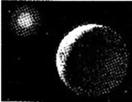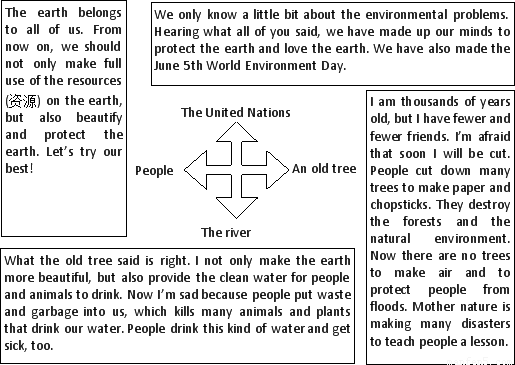题目内容
--An earthquake happened in Indonesia yesterday.
-- _____________ terrible news!
A. How a B. What a C. How D. What
D

 阅读快车系列答案
阅读快车系列答案 After spending years searching for a planet with life, scientists may have found one. In September 2010, a team of US scientists discovered an Earth-sized planet called Gliese 581g. It has a surface temperature neither too hot nor too cold for liquid(液态)water. Scientists think there is a chance that the planet could have life.
After spending years searching for a planet with life, scientists may have found one. In September 2010, a team of US scientists discovered an Earth-sized planet called Gliese 581g. It has a surface temperature neither too hot nor too cold for liquid(液态)water. Scientists think there is a chance that the planet could have life.The planet Gliese 581g goes around a star called Gliese 581, which is about 20 light-years from Earth. That is about 194 trillion(万亿)kilometres -500 million times farther away from us than the moon.
A spacecraft traveling at a one-tenth of the speed of light would reach Gliese 581g within about 220 years. A human can’t live that long, but robotic explorers could make the job easier. However, our fastest spacecraft don’t come anywhere near that one-tenth light-speed mark.
At present, scientists don’t know what the surface might be like on Gliese 581g. What they know is that the planet is at the sight distance from its star to have liquid water. It’s also at the right distance to have an atmosphere that could protect the water if it is on the surface.
Although spacecraft won’t be getting there anytime soon, one way to look for life on Gliese 581g is to turn our radio telescopes(望远镜)towards the planet and search for radiation(放射). By studying the radiation, scientists would find out about the chemicals(化学物质)around the planet and discover it Gliese 581g has an atmosphere. If it has one, studying the atmosphere would give us a good idea if the planet has life or not. But it’ll probably be many years before we can do this properly.
People have been arguing about whether there is alien life on Gliese 581g. Any discussion about alien life is just guessing at this point, according to its discoverers.
【小题1】 What did scientists find in September 2010?
| A.A planet with water. | B.A planet similar to the earth. |
| C.A planet without life. | D.A planet near the earth. |
| A.is at the right distance from its star | B.moves around the earth |
| C.is as far away from us as the moon | D.can be reached in about 220 years |
| A.the possibility of living on Gliese 581g |
| B.the kinds of chemicals around Gliese 581g |
| C.the way of looking for life on Gliese 581g |
| D.the aim of studying the radiation on Gliese 581g |
| A.Gliese 581g, a Likely Living Planet | B.Gliese 581, a Likely Living Planet |
| C.Gliese 581g and Its Star | D.Gliese 581g and Radiation |
 After spending years searching for a planet with life, scientists may have found one. In September 2010, a team of US scientists discovered an Earth-sized planet called Gliese 581g. It has a surface temperature neither too hot nor too cold for liquid(液态)water. Scientists think there is a chance that the planet could have life.
After spending years searching for a planet with life, scientists may have found one. In September 2010, a team of US scientists discovered an Earth-sized planet called Gliese 581g. It has a surface temperature neither too hot nor too cold for liquid(液态)water. Scientists think there is a chance that the planet could have life.
The planet Gliese 581g goes around a star called Gliese 581, which is about 20 light-years from Earth. That is about 194 trillion(万亿)kilometres -500 million times farther away from us than the moon.
A spacecraft traveling at a one-tenth of the speed of light would reach Gliese 581g within about 220 years. A human can’t live that long, but robotic explorers could make the job easier. However, our fastest spacecraft don’t come anywhere near that one-tenth light-speed mark.
At present, scientists don’t know what the surface might be like on Gliese 581g. What they know is that the planet is at the sight distance from its star to have liquid water. It’s also at the right distance to have an atmosphere that could protect the water if it is on the surface.
Although spacecraft won’t be getting there anytime soon, one way to look for life on Gliese 581g is to turn our radio telescopes(望远镜)towards the planet and search for radiation(放射). By studying the radiation, scientists would find out about the chemicals(化学物质)around the planet and discover it Gliese 581g has an atmosphere. If it has one, studying the atmosphere would give us a good idea if the planet has life or not. But it’ll probably be many years before we can do this properly.
People have been arguing about whether there is alien life on Gliese 581g. Any discussion about alien life is just guessing at this point, according to its discoverers.
【小题1】 What did scientists find in September 2010?
| A.A planet with water. | B.A planet similar to the earth. |
| C.A planet without life. | D.A planet near the earth. |
| A.is at the right distance from its star | B.moves around the earth |
| C.is as far away from us as the moon | D.can be reached in about 220 years |
| A.the possibility of living on Gliese 581g |
| B.the kinds of chemicals around Gliese 581g |
| C.the way of looking for life on Gliese 581g |
| D.the aim of studying the radiation on Gliese 581g |
| A.Gliese 581g, a Likely Living Planet | B.Gliese 581, a Likely Living Planet |
| C.Gliese 581g and Its Star | D.Gliese 581g and Radiation |

After spending years searching for a planet with life, scientists may have found one. In September 2010, a team of US scientists discovered an Earth-sized planet called Gliese 581g. It has a surface temperature neither too hot nor too cold for liquid(液态)water. Scientists think there is a chance that the planet could have life.
The planet Gliese 581g goes around a star called Gliese 581, which is about 20 light-years from Earth. That is about 194 trillion(万亿)kilometres -500 million times farther away from us than the moon.
A spacecraft traveling at a one-tenth of the speed of light would reach Gliese 581g within about 220 years. A human can’t live that long, but robotic explorers could make the job easier. However, our fastest spacecraft don’t come anywhere near that one-tenth light-speed mark.
At present, scientists don’t know what the surface might be like on Gliese 581g. What they know is that the planet is at the right distance from its star to have liquid water. It’s also at the right distance to have an atmosphere that could protect the water if it is on the surface.
Although spacecraft won’t be getting there anytime soon, one way to look for life on Gliese 581g is to turn our radio telescopes(望远镜)towards the planet and search for radiation(放射). By studying the radiation, scientists would find out about the chemicals(化学物质)around the planet and discover if Gliese 581g has an atmosphere. If it has one, studying the atmosphere would give us a good idea whether the planet has life or not. But it’ll probably be many years before we can do this properly.
People have been arguing about whether there is alien life on Gliese 581g. Any discussion about alien life is just guessing at this point, according to its discoverers.
【小题1】What did scientists find in September 2010?
| A.A planet with water. | B.A planet similar to the earth. |
| C.A planet without life. | D.A planet near the earth. |
| A.is at the right distance from its star | B.moves around the earth |
| C.is as far away from us as the moon | D.can be reached in about 220 years |
| A.the possibility of living on Gliese 581g |
| B.the kinds of chemicals around Gliese 581g |
| C.the way of looking for life on Gliese 581g |
| D.the aim of studying the radiation on Gliese 581g |
| A.Gliese 581g, a Likely Living Planet | B.Gliese 581, a Likely Living Planet |
| C.Gliese 581g and Its Star | D.Gliese 581g and Radiation |

